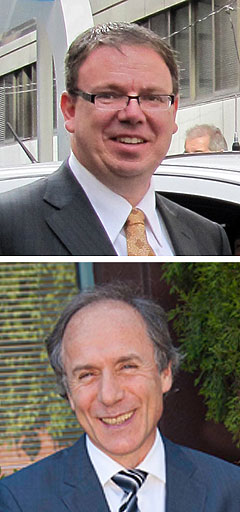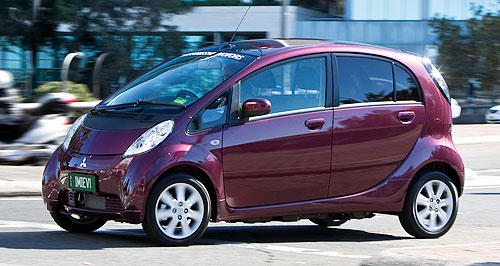Make / Model Search
News - General News - Electric VehiclesBetter Place launches operations centreStart me up: Mitsubishi's i-MiEV will be among the first EVs to use Better Place's Aussie infrastructure. EV network provider opens operations centre ahead of 2011-12 Aussie rollout9 Nov 2010 By IAN PORTER BETTER Place Australia today opened a national operations centre in Melbourne, the latest step in the electric vehicle infrastructure provider’s $1 billion plan to establish a national EV network and accelerate the adoption of all-electric vehicles. Around $600 million will be spent on “charge spots” and battery swap stations and, initially, $400 million on batteries that will be leased or rented to drivers. The new centre will house computers that handle communications between the company and customers’ vehicles and electricity providers, including smart-charging software, monitoring equipment and call centre technology and staff. The opening of the operations centre comes two weeks after Better Place opened its first EV charging station in Canberra, at the Belconnen Mall owned by the company’s first Canberra customer, Rock Development, which is participating in field trials of the Mitsubishi i-MiEV. Speaking at the centre opening, Better Place chief executive Evan Thornley confirmed the company was on track to roll out a full service network in Canberra – a spread of charge spots and a battery swap station – from late 2011. The national rollout is expected to commence late in 2012, with Mr Thornley remaining confident that EVs will achieve quick acceptance from consumers, despite research studies from independent firms such as JD Power and Deloitte showing that the take-up rate will be much slower than EV advocates suggest. He said Australian fleet managers in particular had shown interest in coming onboard, and argued that they would save money now by electrifying their fleets. “We have talked to 73 of the top 100 fleet managers in the last six weeks,” Mr Thornley said. “The average distances travelled across those fleets are between 27,000 and 35,000km a year, although they go up from there for the taxi guys and the rental guys. “All of those vehicles would be in the money if they go electric tomorrow,” he said. “You just have to bring the electric vehicles onboard. The constraint is not the economics. It’s the arrival of mass-manufactured vehicles, and that’s coming quick.” Mr Thornley said the network operations centre would play a key role in ensuring customers did not run out of electricity. “Electric vehicles will not be dumb like petrol cars, which are liable to run out of fuel if you are not careful,” he said. “We will be able to send a warning to our customers that they have only, say, 40km of charge remaining. We will also be able to tell them where the nearest charge spot or battery swap station is, so they don’t run out of electricity.” But Mr Thornley said the battery swap side of the business was not the main game.  Left: Evan Thornley (top) and Alan Finkel Left: Evan Thornley (top) and Alan Finkel“Battery swap is the backup. Most people will not use battery swap that often,” he said. “Everyone has got this petrol station mentality in their heads. That’s not the way it is going to work. “Ninety per cent of the energy in those vehicles, even those that do a lot of driving, will come in through the plug. “But what they need to know is, if they are on a long drive, they’re doing 160km or more, that they can do a refuelling quicker than they can refuel a petrol car.” Mr Thornley added that Better Place’s main aim was to “enable the mass adoption of EVs”. “If we can provide that confidence, then the car-makers will sell a lot more EVs – and quick,” he said. Mr Thornley said Better Place did not need to have millions of EVs on the road to be profitable. “There is a $25 billion liquid fuels market in this country, and it is forecast to reach $40 billion by 2020,” he said. “We are spending $600 million to gain access to that market. We do not need a big market share to get a return on our investment.” Under Better Place’s plan, people will buy an electric car and pay a monthly fee to Better Place for the use of a battery, and the electricity to charge it. “We will cover the upfront cost of the battery and then charge a fee that will be less than the petrol costs people are paying now,” Mr Thornley said. He said many vehicles, especially those owned by fleets, are using “$4000, $5000, $6000 or more” in petrol each year. “The cost of electricity to cover the same distance would be between $1000 and $1500 a year,” he said. “The difference will cover the cost of the battery.” There will be different payment methods available, although Mr Thornley said he was unable to give any indication of pricing yet. Better Place’s chief technology officer Alan Finkel, who is also chancellor of Monash University, said EVs had failed to win acceptance in the past, but that the reasons for the failures no longer applied. He said that in the first phase, around 1900, electric vehicles held 34 per cent of the market and steam cars were dominant. The electric cars were popular with customers but lost out because the batteries were too clumsy and range was small. In the second phase, in the 1990s, the move to electric cars was forced by government legislation in the US, but the same lead-acid batteries brought down the enterprise again. The third phase, still going, is being driven or enabled by customer demand, improved batteries and range, environmental considerations and the rising cost of petrol. Mr Finkel said the lithium-ion phosphate battery was “truly fantastic”, offering four times the carrying capacity of a lead-acid battery. In addition, it just “goes and goes and goes”, he said. It also used stable, non-toxic materials, had a high crash tolerance and was 90-95 per cent recyclable.  Read more |
Click to shareGeneral News articlesResearch General News Motor industry news |











Facebook Twitter Instagram